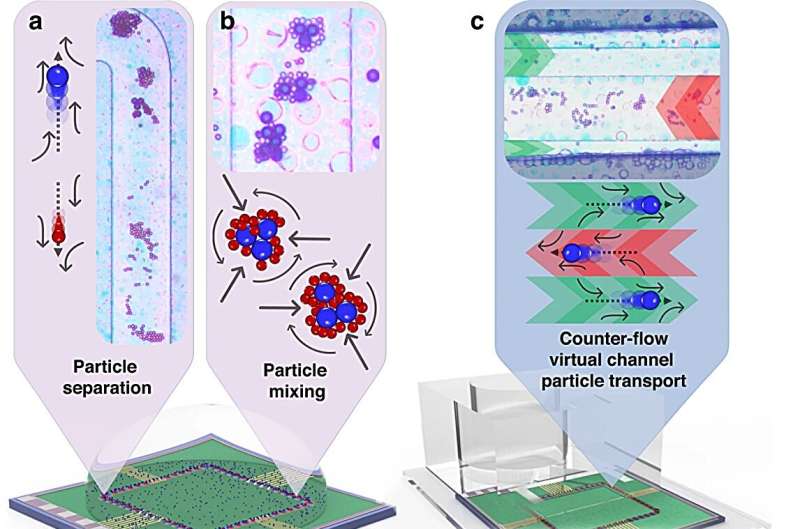New technology using sound waves has implications for nanoparticle manipulation

Acoustofluidics elegantly merges acoustics with fluid mechanics, enabling precise manipulation of fluids and particles on both micro and nanoscales. This interdisciplinary field plays a crucial role in biomedicine, tissue engineering, and nanoparticles synthesis. However, the effectiveness and potential of traditional acoustofluidic devices are often curtailed by their dependency on the specific geometries of fluidic chambers, thus limiting their adaptability and versatility.
Addressing these limitations, the membrane acoustic waveguide actuator (MAWA) technology utilizes guided flexural waves (GFWs) for efficient and flexible particle control, which operates independently of the chamber’s resonance properties due to the evanescent properties of the GFW-powered acoustic fields.
This approach was detailed in a study published in Microsystems & Nanoengineering on 8 March 2024.
Unlike traditional methods that depend heavily on the specific design of microfluidic chambers, MAWA utilizes sound waves by guiding the vibrations along micron-thin microfabricated membranes acting as acoustic waveguide, without limitations from the surrounding geometry.
This innovation enables scientists to precisely control the movement of particles on top of the membranes, whether it’s for mixing, separating, or transporting them within any fluidic space on a microchip.
The research delves deep into the mechanics of how these guided sound waves interact with particles in a fluid, offering a glimpse into a future where lab-on-a-chip devices are more versatile and powerful than ever before.
Experiments demonstrated that by adjusting the frequency and phase of these sound waves, particles could be made to mix, separate based on size, or even move against a fluid’s flow all within the confines of a tiny droplet or a microchannel.
According to the first author Dr. Philippe Vachon, “Our research on microfluidic technology brings forth significant advancements in particle manipulation functions through localized acoustofluidic effects. This cavity-agnostic guided-flexural-waves-based approach opens new avenues for the design and application of lab-on-a-chip devices. Hopefully, this new technology will greatly contribute to future breakthroughs in lab-on-a-chip systems targeted at disease diagnostic and cellular level assays.”
More information:
Philippe Vachon et al, Cavity-agnostic acoustofluidic manipulations enabled by guided flexural waves on a membrane acoustic waveguide actuator, Microsystems & Nanoengineering (2024). DOI: 10.1038/s41378-023-00643-8
Citation:
Breaking boundaries in tiny labs: New technology using sound waves has implications for nanoparticle manipulation (2024, April 23)
retrieved 23 April 2024
from https://phys.org/news/2024-04-boundaries-tiny-labs-technology-implications.html
This document is subject to copyright. Apart from any fair dealing for the purpose of private study or research, no
part may be reproduced without the written permission. The content is provided for information purposes only.

